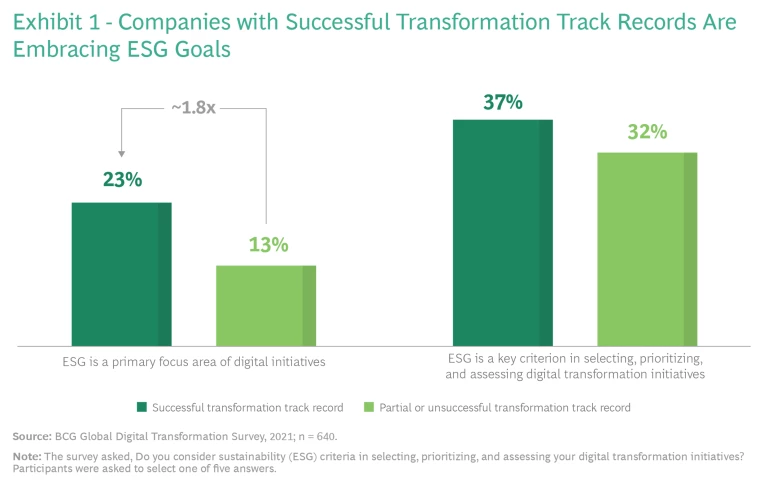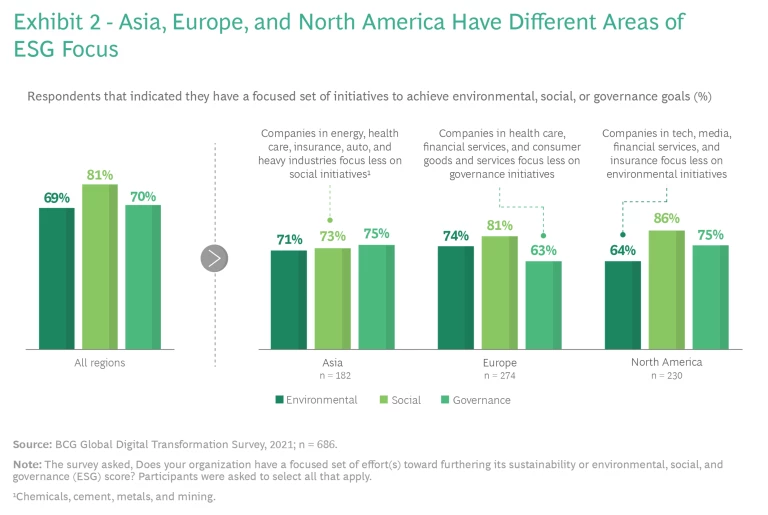Sustainability is at the top of corporate agendas worldwide, and environmental, social, and governance (ESG) goals have become major considerations in companies’ digital transformation programs. In BCG’s latest research into digital transformations, more than 60% of survey respondents listed ESG factors as a primary focus or a key criterion for selecting and prioritizing digital initiatives, and more than 80% of companies plan to increase their investments in sustainability. But putting ESG at the top of the priority list does not guarantee success.

Our research, which involved more than 850 companies worldwide, shows a clear link between digital capabilities and sustainability. Companies that are successful in their digital transformations are almost twice as likely as other organizations to see ESG goals as a key focus of digital initiatives. (See Exhibit 1.) One reason is that successful transformers shift from digital reengineering to innovation as they look beyond the challenges of delivering a transformation and focus on how their new capabilities can help tackle broader opportunities in the company agenda.
We also believe that leaders merge their digital and sustainability agendas. Our latest research indicates that digital capabilities are critical enablers for sustainability initiatives and that there are digital prerequisites for achieving sustainability goals. We explore these in more depth below. But let’s look first at how companies are setting their E, S, and G digital priorities.
Industry, Company, and Regional E, S, and G Priorities
There are significant differences among industries regarding the importance that companies put on ESG and how much each industry emphasizes the E, S, and G. While one in four companies overall makes ESG the primary focus area of its digital transformations, the percentage in individual industries ranges from almost twice that (in medtech, biopharma, and automotive) to about one in ten (for telecommunications, software, and fashion and luxury). (See the interactive.) But even in the lagging industries, digital leaders put a high priority on ESG: 38% for telecommunications and 64% for software, for example.
At the same time, while climate change has put environmental considerations front and center, company investments cover all three aspects of sustainability. Overall, 80%, 70%, and 69% of companies have digital initiatives that focus on social goals, governance considerations, and environmental programs, respectively. Again, there are significant differences by industry as well as by region. Companies in more people-centric industries (both employee- and customer-focused sectors), such as health care and consumer goods and services, are most likely to prioritize social initiatives, while energy companies and industrial goods manufacturers emphasize environmental initiatives. Governance and social initiatives are top priorities among financial institutions and insurance companies. Rising cyber attacks and the shift to more remote ways of working are driving these concerns.

Regionally, social initiatives are the most-pursued priority in North America and Europe, where diversity, equity, and inclusion concerns run high, while governance initiatives rank first in Asia. Companies in Europe (74%) and Asia (71%), where most countries are net energy consumers, are more likely to prioritize environmental initiatives than companies in North America (64%), a major center of fossil fuel production as well as use. (See Exhibit 2.)
Using Digital Technologies to Drive the ESG Agenda
For leaders that think broadly about how to advance their sustainability initiatives, technology can act as a major accelerant. We call this mindset technology ecoadvantage—using advanced technologies and ways of working to enable profitable solutions that also have a positive impact on ESG goals. Employing advanced digital tools requires having certain capabilities in place. Here are five prerequisites that our research and experience show are critical to moving ESG initiatives forward.
Sustainability and growth need to be thought about together. Sustainability presents opportunities for both growth and cost reduction, putting the need to reduce carbon footprints or to comply with social or governance regulations in a new light. These opportunities can involve disrupting a company’s own core business by offering low-carbon alternatives or creating new products and services that expand accessibility. For example, Norwegian crop-nutrition company Yara International, which was established in 1905 as the world’s first producer of mineral nitrogen fertilizers, today offers a portfolio of digital farming solutions that enable farmers to maximize the yield and quality of their harvests while reducing environmental impact. As the company’s CEO puts it, “Over the past decades, Yara has moved from an owner of assets and producer of fertilizer to becoming a complete solutions provider, both for farmers and food companies. We are transitioning from growing volume to growing value.”
Such opportunities require companies to be able to innovate quickly and foster innovation across the entire organization. Digital capabilities—such as fully agile teams that can make and implement decisions independently, performance-based funding mechanisms, and rapid and flexible technology adoption—are crucial for companies to enable such innovation.
You cannot systematically reduce what you can’t measure. Our study clearly shows that companies are using digital tools in a variety of ways to assess their opportunities and their progress. At the level of individual initiatives, top environmental priorities include supply chain optimization (a priority for 83% of respondents); reducing energy consumption in offices, factories, and buildings (78%); and using analytics to reduce waste (73%). Top social priorities are ensuring the protection of clients’, employees’, and customers’ data (86%); improving employee collaboration with digital platforms (83%); and improving diversity and inclusion (80%). Critical-incident risk management (including building cyber resilience), real-time monitoring of risk, and predictive risk analytics are the three biggest areas of governance concern, focus, and priorities for 89%, 86%, and 82% of respondents, respectively.
But the real value comes from the ability to integrate internal data with data from a broader supply chain or ecosystem so as to identify areas of intervention beyond the company’s own processes. This requires infrastructure based on application programming interfaces as well as advanced people capabilities to manage the data collection and analysis and orchestrate the relevant conversations. For example, BCG has developed CO2 AI, an end-to-end software solution that accurately measures emissions directly produced by a company’s own activities and quantifies the more difficult-to-measure, indirect emissions produced along the company’s entire value chain.
The real value of digital tools comes from the ability to integrate internal data with data from a supply chain or an ecosystem.
Dynamic environments mandate digital decision-making support. Reducing a company’s carbon footprint often means making hard and complex decisions that turn ways of working upside down. Redesigning a supply chain, for instance, or rethinking a service delivery model from in-person to remote are big changes affecting both people and processes. Analysis paralysis is a real risk when the variables are many and the cost of making mistakes is high.
Being able to leverage artificial intelligence (AI) and advanced analytics to support such decisions enables companies to move faster and more assuredly—and make bolder moves. A leading European minerals company, for instance, used a digitally enabled energy control tower with a cloud-enabled data platform and AI and advanced analytics to create an end-to-end model for an integrated energy-management solution. As a result, it achieved a reduction in energy consumption of 5% to 10%, and it is on track to save €8 million to €9 million a year in costs. But being able to rely on AI requires very advanced data capabilities and a familiarity and comfort level with advanced tools that can only be gained through time.
Risk tracking, monitoring, and mitigation is more important than ever. Being able to quantify the risks associated with such external factors as climate change (for instance, the impact from a combination of adverse events) or cyber incidents (data theft or a system hack, for example) are fast-rising priorities for many companies. In fact, 89% and 86% of companies, respectively, have made critical-incident risk management and real-time tracking of risks digital priority initiatives.
Understanding how external events can affect the supply chain, supplier base, or customers in real time, and being able to translate such risks into financial impact, is a complex undertaking. Having access to the right data, algorithms, decision mechanism, and governance is key. Moreover, these capabilities enable companies to achieve a level of transparency on decision making and accountability, both internally and externally, that would otherwise not be possible, leading to not only better risk avoidance but also faster and more effective mitigation efforts.
Access to platforms and ecosystems is key. Most companies cannot solve climate and other sustainability issues on their own, or within the time frames necessary, to have a broader social impact. For example, 72% of companies cite collecting data across the Internet of Things (IoT), monitoring production processes, and assessing environmental impact as priorities. Digital capabilities are essential to tapping into innovation platforms and ecosystems, such as those orchestrated by Caterpillar and John Deere in agriculture; Honeywell in data from IoT; and Schneider Electric in power generation and use. It is not necessary to orchestrate a new ecosystem, and not every company is in a position to play the role of orchestrator. Contributing to an existing ecosystem can be just as attractive.
Achieving ESG goals—and building sustainability as a competitive advantage—requires integrating technology and data from the start. Making sure the digital prerequisites for ESG initiatives are in place is a critical first step.




